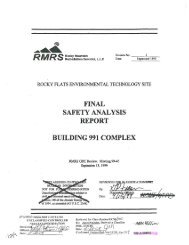silo 3 - U.S. Department of Energy
silo 3 - U.S. Department of Energy
silo 3 - U.S. Department of Energy
Create successful ePaper yourself
Turn your PDF publications into a flip-book with our unique Google optimized e-Paper software.
E N 0 I N E E R I N GQP<br />
Transport and Dose Calculation using CAPSI-PC<br />
- 5069<br />
- - -<br />
Calculation- -- -- - -<br />
Project:<br />
Calculation Number:<br />
PageNod <strong>of</strong>-<br />
35H19605<br />
40430-CA-0003<br />
The atmospheric releasddispersiodexposure calculations were performed usin the annual estimated<br />
release rates, Table 2, for the major radionuclides in the Silo 3 waste, includingg'QRn, 210Rn and =Rn.<br />
Radionuclide concentrations and doses were calculated as a function <strong>of</strong> 16 uniformly distributed directions<br />
and potential receptor/monitoring station locations <strong>of</strong> 332 m, 527 m, 582 m, 930 m, QQlm, 994 m, 1064 rn,<br />
1241 m, 1320 rn, 1356 m, 1390 rn, 1454 m, 1457 rn, 1497 m. and 1506 rn from the stack. In addition, the<br />
location <strong>of</strong> the maximum exposure and dose is determined.<br />
Five CAP88-PC input files and execution runs were performed: 1) particulate releases during Phase 1,<br />
and 2, and 2) specific radon isotope releases for each project phase. The calculated results are detailed<br />
in ATTACHMENT C. The dose is not calculated for the initial headspace venting since the source term<br />
released in negligible. T,h" initial 48 mCi release is less than the average released per - day -. during removai --<br />
activities (e.g., 6.63 x 10 pCilmin or 95 mCilday)<br />
The maximum exposure/dose occurs at a distance <strong>of</strong> 994 m from the stack and in the north-easterly<br />
direction, for both the particulate and =Rn releases. Maximum exposure to *'Fin and =Rn occurs at<br />
332 m in the north-easterly direction, which is closer to the stack release location relative to the particulate<br />
and =Rn maximum exposure/dose location. This is due to the shorter half-life <strong>of</strong> 2'DRn (4s) and ='Rn<br />
(55s).<br />
Exposure <strong>of</strong> a hypothetical rural receptor, at 994 m northeast, to particulates resulting from the retrieval<br />
and packaging <strong>of</strong> Silo 3 waste would yield an estimated dose <strong>of</strong> 6.40 x lo4 mrew during Phase 1, and<br />
4.33 x lo4 mrem/yr during Phase 2. Dose rates due to isotopic radon that do not emanate from the solid<br />
particulate matrii and is atmospherically dispersed were not evaluated and are considered to insignificant.<br />
Thorium-230 is the largest contributor to risk. The 2?h concentration at the location <strong>of</strong> maximum dose is<br />
approximately 2.6 x 10'" pCVL and 1.7 x 10'" pCVL, during Phase 1 and 2, respectively.<br />
I<br />
Radoq<br />
The CAP-88 output for the release <strong>of</strong> various radon isotopes are shown in Attachment C3 - C8. The<br />
maximum concentration and dose due to =Rn and daughters occurs at 994 rn from Silo 3 in the north-<br />
easterly direction - The =Rn concentrations at this location are 1.5 x lo4 pCVL for both Phases 1 and 2.<br />
The dose-rates due to pure radon inhalation are 0.033 mremEyr for both Phases 1 and 2.<br />
The =Rn progeny dose is expressed in terms <strong>of</strong> working level, which is adjusted for a 31% equilibrium<br />
fraction at 994 m. The working level (WL) concentrations for Phase 1 and 2 are 4.76 x lob at the<br />
maximum exposure location. The dose for this working level can be correlated to dose assuming an 100%<br />
exposure time duration outdoors by using the outdoor conversion factor <strong>of</strong> 570 mremMILM, where a<br />
working level month, WLM, is 170 hours <strong>of</strong> exposure. Therefore, Phase 1 and 2 doserates are<br />
Dose-rate for Phase 1 and 2 = 4.76 x lo4 WL x (8760 hrs/yr / 170 hrs/mo) x 570 mremMlLM<br />
= 0.14 mremw.<br />
The total dose-rate from =Rn and progeny for a receptor located at 994 m from Silo 3 in NE direction are:<br />
Total dose-rate for Phase 1 and 2 = 0.033 + 0.14 = 0.17 mremlyr<br />
The corresponding =Rn dose conversion factor is approximately 0.01 1 pCVL per mrem/yr at 31 percent<br />
equilibrium, the assumed exposure durations, and at the stated dose conversion factor <strong>of</strong> 570 mrem<br />
008223
















